Indice
- Introduction to Venice: A City Like No Other
- The Rich History and Cultural Heritage of Venice
- Must-See Landmarks and Attractions in Venice
- Off the Beaten Path: Hidden Gems in Venice
- Venetian Cuisine: What to Eat and Where to Find It
- Best Beaches and Swimming Spots Near Venice
- Where to Stay: Accommodation Options for All Budgets
- Getting Around Venice: Transportation Tips and Tricks
- Day Trips from Venice: Exploring the Surrounding Areas
- 7-Day Itinerary: Making the Most of Your Venice Trip
- Seasonal Events and Festivals in Venice
- Responsible Tourism: Preserving Venice’s Fragile Ecosystem
- Conclusion: Embracing the Magic of Venice
Introduction to Venice: A City Like No Other
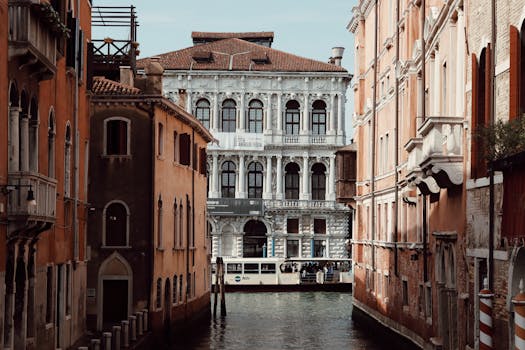
The Floating City: A Marvel of Human Ingenuity
Venice, often referred to as La Serenissima (The Most Serene), is a city that defies imagination. Built on 118 small islands in the Venetian Lagoon, this UNESCO World Heritage site is a testament to human perseverance and architectural genius. Founded in the 5th century AD, Venice rose to become a major maritime power during the Middle Ages and Renaissance. Today, its intricate network of canals, stunning palaces, and rich artistic heritage make it one of the world’s most unique and beloved destinations.
A Labyrinth of Beauty: Navigating Venice’s Charms
Exploring Venice is like stepping into a living museum. The city’s layout, free from cars and modern urban planning, invites visitors to lose themselves in its narrow calli (streets) and discover hidden gems around every corner. From the grandeur of St. Mark’s Square to the quiet charm of lesser-known neighborhoods like Cannaregio or Dorsoduro, Venice offers an unparalleled blend of historical significance and romantic atmosphere. The city’s heart and main thoroughfare is the Grand Canal, lined with palaces that showcase centuries of Venetian architecture.
Seasons of Enchantment: When to Visit Venice
While Venice is captivating year-round, each season offers a unique perspective on the city. Spring (April to June) brings mild weather and fewer crowds, ideal for exploring outdoor attractions. Summer (July to August) is peak tourist season, with festivals like the Biennale and Festa del Redentore in full swing. Autumn (September to November) offers pleasant temperatures and cultural events like the Venice Film Festival. Winter (December to March) transforms Venice into a misty, ethereal landscape, with the added magic of Carnival celebrations in February. Regardless of when you visit, Venice’s timeless beauty and rich cultural tapestry promise an unforgettable experience.
The Rich History and Cultural Heritage of Venice
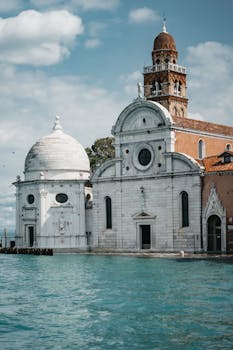
From Maritime Republic to Cultural Icon
Venice’s history is as intricate as its canals. Founded in the 5th century by refugees fleeing barbarian invasions, Venice quickly evolved into a powerful maritime republic. By the 13th century, it had become a dominant trading power, controlling much of the Mediterranean trade routes. This period, known as the Golden Age of Venice, saw the construction of many of the city’s iconic buildings, including the Doge’s Palace and St. Mark’s Basilica. Venice’s unique position as a crossroads between East and West influenced its art, architecture, and culture, creating a distinctive Venetian style that still captivates visitors today.
The Legacy of Venetian Art and Architecture
Venice’s cultural heritage is embodied in its stunning architecture and rich artistic traditions. The city was home to renowned Renaissance painters like Titian, Tintoretto, and Veronese, whose works adorn churches and palaces throughout Venice. The Venetian Gothic style, exemplified by buildings like Ca’ d’Oro, combines Byzantine, Islamic, and Gothic elements, reflecting Venice’s cosmopolitan history. The city’s famous Murano glass and intricate lace from the island of Burano showcase Venice’s artisanal traditions that have endured for centuries.
Festivals and Traditions: Keeping History Alive
Venice’s cultural calendar is filled with events that celebrate its rich history. The Carnival of Venice, with its elaborate masks and costumes, dates back to the 13th century and remains one of the world’s most famous festivals. The Festa del Redentore, commemorating the end of a devastating plague in 1576, features a spectacular fireworks display over the lagoon. The Regata Storica, a historical boat race held each September, pays homage to Venice’s maritime heritage with a parade of 16th-century-style boats along the Grand Canal. These events, along with countless local traditions, ensure that Venice’s unique culture continues to thrive in the modern era.
Must-See Landmarks and Attractions in Venice
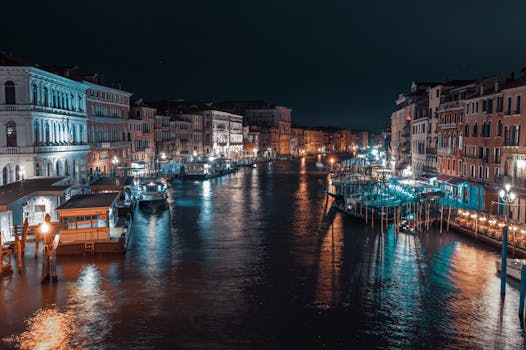
St. Mark’s Square: The Heart of Venice
Piazza San Marco, or St. Mark’s Square, is the epicenter of Venetian life and a must-visit destination for any traveler. Dominated by the stunning St. Mark’s Basilica, this expansive square is surrounded by architectural marvels. The basilica itself, with its Byzantine domes and intricate mosaics, is a testament to Venice’s historical connections with the East. Adjacent to the basilica stands the imposing Campanile, a 98.6-meter bell tower offering panoramic views of the city. The square is also home to the Doge’s Palace, a masterpiece of Gothic architecture that once housed the Venetian Republic’s government.
The Grand Canal and Its Palaces
No visit to Venice is complete without experiencing the Grand Canal, the city’s main waterway. Stretching for 3.8 kilometers, it is lined with over 170 buildings, many dating back to the 13th to 18th centuries. A vaporetto (water bus) ride or a romantic gondola trip allows visitors to admire palaces like the Ca’ d’Oro, a prime example of Venetian Gothic architecture, and the Palazzo Grassi, now a contemporary art museum. The iconic Rialto Bridge, one of the four bridges spanning the Grand Canal, offers a picturesque spot for photos and a vibrant market area.
Hidden Gems: Beyond the Tourist Trail
While the main attractions are undoubtedly spectacular, Venice’s charm also lies in its lesser-known sights. The Libreria Acqua Alta, a unique bookstore where books are stored in bathtubs and gondolas to protect them from flooding, is a bibliophile’s paradise. The Jewish Ghetto, established in 1516, offers a glimpse into a different side of Venetian history with its synagogues and museums. For art enthusiasts, the Peggy Guggenheim Collection houses an impressive array of modern art in an 18th-century palazzo on the Grand Canal. These hidden treasures provide a more intimate and authentic Venetian experience, away from the crowds of the main tourist areas.
Off the Beaten Path: Hidden Gems in Venice
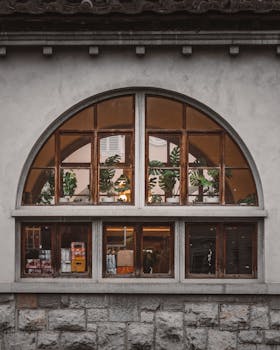
Discovering Venice’s Secret Canals
While the Grand Canal steals the spotlight, Venice’s true charm lies in its network of smaller, hidden canals. The Rio di San Boldo in the San Polo district offers a tranquil escape from the bustling tourist areas. Here, you’ll find the charming Ponte del Chiodo, one of the last remaining bridges in Venice without parapets. For a truly local experience, explore the canals of the Cannaregio district, where you can stumble upon hidden gems like the Madonna dell’Orto Church, home to some of Tintoretto’s masterpieces.
Hidden Gardens and Green Spaces
Contrary to popular belief, Venice has several lush green oases tucked away from public view. The Giardini della Biennale, while known for hosting the Venice Biennale, offers peaceful walks among pavilions and trees when not in use for exhibitions. For a more secluded experience, seek out the Giardino Nascosto (Hidden Garden) near Campo San Zaccaria. This small, walled garden provides a quiet retreat with its ancient well and fragrant flowers. Don’t miss the opportunity to visit Venice’s only vineyard, hidden behind the walls of San Francesco della Vigna monastery in Castello.
Artisan Workshops and Local Crafts
Venture beyond the tourist shops to discover Venice’s rich artisanal heritage. In the Dorsoduro district, visit the workshop of Saverio Pastor, one of the last traditional oar and forcola (rowlock) makers in Venice. For a unique souvenir, explore the Giudecca island to find the workshop of Marisa Convento, a master beadworker who creates stunning jewelry and accessories using traditional Venetian glass beads. In the Castello district, the small Acqua Alta Vinyl Record Shop offers a treasure trove for music lovers, with its eclectic collection housed in a charming, cluttered space reminiscent of the famous Libreria Acqua Alta.
Venetian Cuisine: What to Eat and Where to Find It

Seafood Specialties: The Heart of Venetian Cuisine
Venetian cuisine is deeply rooted in its lagoon environment, with seafood playing a starring role in many traditional dishes. Don’t miss the chance to try baccalà mantecato, a creamy whipped salt cod spread typically served on polenta. Another local favorite is sarde in saor, sweet and sour sardines marinated with onions, raisins, and pine nuts. For a truly authentic experience, head to Osteria Al Squero in Dorsoduro, where you can enjoy these delicacies alongside a view of gondolas being repaired at the adjacent boatyard.
Risotto and Pasta: Venetian Style
Venice puts its own spin on Italian staples like risotto and pasta. Risotto al nero di seppia, a striking black risotto colored and flavored with cuttlefish ink, is a must-try for adventurous eaters. For pasta lovers, bigoli in salsa, a thick whole-wheat spaghetti served with an anchovy and onion sauce, offers a taste of Venetian tradition. Sample these dishes at Antiche Carampane, a hidden gem in the San Polo district known for its fresh, locally-sourced ingredients.
Sweet Treats and Venetian Drinks
No culinary journey through Venice is complete without indulging in its sweet offerings. Tiramisu, though claimed by several Italian regions, is said to have originated in nearby Treviso and is a staple in Venetian cafes. During Carnival season, look for frittelle, delicious fried dough balls filled with cream or raisins. To drink, try the famous Bellini, a cocktail of prosecco and peach purée invented at Harry’s Bar, or sample Spritz, the city’s iconic aperitif. For a memorable dessert experience, visit Pasticceria Rizzardini, one of the oldest pastry shops in Venice, dating back to 1742.
Best Beaches and Swimming Spots Near Venice
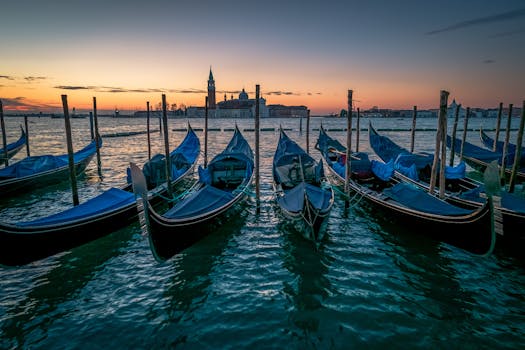
Lido di Venezia: Venice’s Own Beach Paradise
Just a short vaporetto ride from the heart of Venice lies the Lido di Venezia, an 11-kilometer-long sandbar that boasts some of the most beautiful beaches in the Venetian Lagoon. The Lido’s most famous beach, Spiaggia di San Nicolò, offers golden sands and calm waters perfect for swimming. This Blue Flag beach is equipped with amenities including sun loungers, umbrellas, and beach clubs. For a more secluded experience, head to the southern end of the Lido to Alberoni Beach, a natural oasis with sand dunes and pine forests.
Jesolo and Cavallino: Family-Friendly Beach Destinations
A short distance from Venice, the seaside towns of Jesolo and Cavallino offer expansive beaches ideal for families and sun-seekers. Jesolo boasts a 15-kilometer stretch of golden sand, lined with hotels, restaurants, and entertainment options. The shallow waters make it perfect for children, while water sports enthusiasts can enjoy activities like windsurfing and kitesurfing. Cavallino, known for its campgrounds and holiday resorts, offers a more relaxed atmosphere with its long, wide beaches and pine forests backing onto the shore.
Hidden Gems: Lesser-Known Swimming Spots
For those looking to escape the crowds, several hidden swimming spots near Venice offer unique experiences. The island of Pellestrina, south of the Lido, is a narrow strip of land with beautiful, uncrowded beaches on its Adriatic side. Here, you can enjoy a peaceful swim and observe local fishermen at work. Another off-the-beaten-path option is Punta Sabbioni, located at the northern end of the Cavallino peninsula. This area features a lighthouse and pristine beaches with views of the Venetian Lagoon. For a truly local experience, take a boat to the island of Sant’Erasmo, known as the “garden of Venice,” where you can swim in the calm waters of its small beaches and enjoy the rural landscape.
Where to Stay: Accommodation Options for All Budgets
Luxury Stays: Indulge in Venetian Opulence
For those seeking the ultimate Venetian experience, the city offers an array of luxurious accommodations that reflect its rich history and elegance. The iconic Gritti Palace, a 15th-century palazzo on the Grand Canal, provides guests with unparalleled views and sumptuous interiors adorned with antiques and Murano glass chandeliers. Another exquisite option is the Aman Venice, housed in the 16th-century Palazzo Papadopoli, which combines Renaissance architecture with contemporary comfort. For a more intimate experience, the Ca’ Maria Adele in the quiet Dorsoduro district offers themed suites that transport guests to the golden age of Venetian nobility.
Mid-Range Comfort: Charming Hotels and B&Bs
Venice boasts numerous charming mid-range hotels and bed & breakfasts that offer comfort without breaking the bank. The Hotel Palazzo Stern, located in a historic palace on the Grand Canal, provides elegant rooms at more accessible prices. In the heart of the city, the Hotel Saturnia & International offers a blend of traditional Venetian style and modern amenities. For a more local experience, consider staying at Ca’ della Corte, a lovely B&B housed in a 16th-century building in the Santa Croce district, known for its friendly hosts and homely atmosphere.
Budget-Friendly Options: Hostels and Guesthouses
Traveling on a budget doesn’t mean missing out on the Venetian experience. The city offers several affordable hostels and guesthouses that provide comfortable accommodations in convenient locations. The Generator Venice, situated on the island of Giudecca, offers dormitory-style and private rooms with stunning views of the city skyline. In the Cannaregio district, the Combo Venezia hostel, set in a converted 12th-century convent, provides a unique blend of history and modern design. For those preferring a more traditional guesthouse, the Casa Burano on the colorful island of Burano offers an authentic experience of life in the Venetian Lagoon at reasonable rates.
Getting Around Venice: Transportation Tips and Tricks
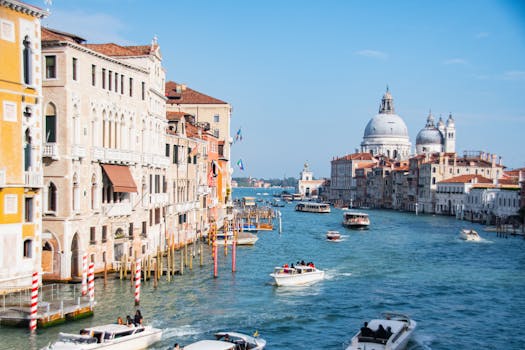
Navigating the Canals: Vaporetti and Water Taxis
Venice’s unique geography means that water-based transportation is key to getting around the city. The primary mode of public transport is the vaporetto, Venice’s water bus system operated by ACTV. These boats run regularly along the Grand Canal and to outlying islands, offering an efficient and scenic way to travel. For a more direct and luxurious option, water taxis are available, though they come at a premium price. To make the most of your stay, consider purchasing a multi-day vaporetto pass, which allows unlimited travel and can save you money if you plan to use the water buses frequently.
On Foot: Exploring Venice’s Labyrinthine Streets
Walking is arguably the best way to experience Venice’s charm. The city’s compact nature means that many attractions are within walking distance of each other. However, navigating Venice’s maze-like streets can be challenging. Invest in a good map or a reliable offline navigation app, as the narrow calli (streets) can be confusing even for experienced travelers. Don’t be afraid to get lost – some of Venice’s most delightful discoveries happen when you wander off the beaten path. For those with mobility issues, be aware that Venice has numerous bridges, many with steps, which can make wheelchair access challenging in some areas.
Gondolas: A Quintessential Venetian Experience
While not a practical mode of everyday transportation, a gondola ride is a quintessential Venetian experience. These iconic boats offer a romantic and intimate way to explore the city’s smaller canals. Gondola rides are regulated by the city, with set rates for standard trips. For a more budget-friendly alternative that still captures the gondola experience, consider taking a traghetto. These larger gondolas serve as ferry crossings at several points along the Grand Canal, offering a short but authentic taste of gondola travel at a fraction of the cost.
Day Trips from Venice: Exploring the Surrounding Areas
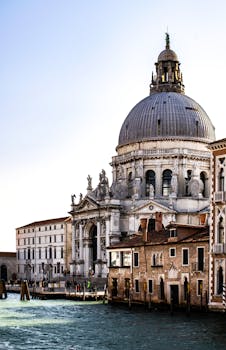
Burano and Murano: Islands of Color and Glass
Just a short vaporetto ride from Venice, the islands of Burano and Murano offer delightful day trip experiences. Burano, famous for its brightly colored houses and lace-making tradition, is a photographer’s paradise. Stroll along the canals, visit the Lace Museum, and enjoy fresh seafood at local trattorias. Murano, renowned for its glassmaking heritage, offers visitors the chance to watch master glassblowers at work in their studios. Don’t miss the Museo del Vetro (Glass Museum) to learn about the island’s centuries-old craft.
Padua: A Renaissance Gem
Less than an hour from Venice by train, Padua is a city steeped in history and art. Home to one of the world’s oldest universities, Padua boasts impressive architectural sights like the Basilica of Saint Anthony and the Scrovegni Chapel, featuring Giotto’s revolutionary frescoes. The bustling Piazza delle Erbe and Piazza della Frutta offer vibrant market scenes and charming cafes. Nature lovers should visit the Orto Botanico, the world’s oldest academic botanical garden, established in 1545.
Verona: City of Romeo and Juliet
A 1.5-hour train ride from Venice, Verona is a romantic city famous as the setting of Shakespeare’s “Romeo and Juliet.” Visit Juliet’s House with its iconic balcony, explore the remarkably preserved 1st-century Arena di Verona, which still hosts operas and concerts, and wander through the charming streets of the historic center. The Piazza delle Erbe, Verona’s main square, is perfect for people-watching and enjoying local cuisine. For panoramic views of the city, climb to the top of the Torre dei Lamberti.
7-Day Itinerary: Making the Most of Your Venice Trip
Days 1-3: Exploring Venice’s Heart
Begin your Venetian adventure with a deep dive into the city’s core. On Day 1, start at St. Mark’s Square, visiting the Basilica di San Marco and climbing the Campanile for panoramic views. Explore the Doge’s Palace and cross the Bridge of Sighs. Spend the afternoon getting lost in the narrow streets of San Marco and Castello districts. Day 2 should be dedicated to the Grand Canal. Take a vaporetto ride, stopping at the Rialto Bridge and market. Visit the Peggy Guggenheim Collection and end the day with a sunset gondola ride. On Day 3, explore the Dorsoduro district, home to the Gallerie dell’Accademia and the iconic Basilica di Santa Maria della Salute.
Days 4-5: Venturing to the Islands
Dedicate Day 4 to exploring the colorful islands of the Venetian Lagoon. Start early with a trip to Murano, famous for its glassmaking. Watch artisans at work and visit the Glass Museum. In the afternoon, head to Burano, known for its brightly colored houses and lace-making tradition. On Day 5, venture to the lesser-known island of Torcello, home to the oldest building in Venice, the Cathedral of Santa Maria Assunta. Return to Venice and spend the evening exploring the vibrant Cannaregio district, enjoying cicchetti (Venetian tapas) at local bacari.
Days 6-7: Hidden Gems and Day Trips
On Day 6, uncover Venice’s hidden gems. Visit the Libreria Acqua Alta, explore the Jewish Ghetto, and take a tour of the Scala Contarini del Bovolo, a hidden architectural marvel. Spend the afternoon relaxing at the Lido, Venice’s beach island. For your final day, choose a day trip based on your interests. Art and history enthusiasts might opt for Padua to see Giotto’s frescoes, while romantics could head to Verona, the city of Romeo and Juliet. Alternatively, stay in Venice to revisit favorite spots or do last-minute shopping for Murano glass and Venetian masks. End your trip with a farewell dinner at a traditional Venetian restaurant, savoring local specialties and reflecting on your unforgettable week in La Serenissima.
Seasonal Events and Festivals in Venice
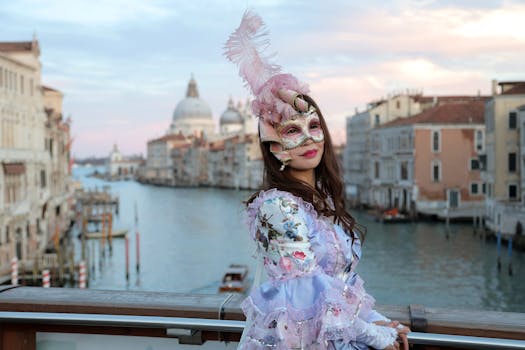
Carnival of Venice: A Spectacular Winter Celebration
The Carnival of Venice is one of the world’s most famous festivals, transforming the city into a magical realm of masks and costumes every February. Dating back to the 13th century, this annual event attracts millions of visitors who come to witness the elaborate masquerade balls, gondola parades, and street performances. The highlight of the carnival is the contest for the best mask, held in St. Mark’s Square. Visitors can participate by donning traditional Venetian masks and costumes, available for rent or purchase throughout the city. The carnival’s enigmatic atmosphere provides a unique opportunity to experience Venice at its most mysterious and enchanting.
Festa del Redentore: A Midsummer Night’s Dream
Held annually on the third weekend of July, the Festa del Redentore (Feast of the Redeemer) is a beloved Venetian tradition that dates back to 1577. This festival commemorates the end of a devastating plague and centers around the Church of the Redentore on Giudecca Island. The celebration begins on Saturday evening with a spectacular fireworks display over the Bacino di San Marco. Venetians and tourists alike gather on boats in the lagoon or along the waterfront to watch the sky light up in a dazzling array of colors. Sunday features religious services and a gondola regatta, offering a mix of solemn tradition and joyous celebration.
Venice Film Festival: Glamour on the Lido
The Venice International Film Festival, part of the prestigious Venice Biennale, takes place annually in late August to early September on the Lido di Venezia. As the world’s oldest film festival, it attracts top filmmakers, actors, and cinema enthusiasts from around the globe. The event transforms the Lido into a hub of glamour and artistic expression, with red carpet premieres, exclusive parties, and thought-provoking film screenings. Visitors can purchase tickets to public screenings or simply enjoy the festival atmosphere and potential celebrity sightings. The Golden Lion, the festival’s highest honor, is one of the most coveted awards in the film industry, making this event a must-see for cinema lovers.
Responsible Tourism: Preserving Venice’s Fragile Ecosystem
Understanding Venice’s Environmental Challenges
Venice faces unique environmental challenges due to its location in a lagoon. The city is experiencing more frequent acqua alta (high water) events, and rising sea levels pose a significant threat to its historic architecture. Overtourism has also put a strain on the city’s infrastructure and ecosystem. Visitors can help by being aware of these issues and taking steps to minimize their impact. Choose eco-friendly accommodations, respect local regulations, and consider visiting during off-peak seasons to reduce crowding.
Sustainable Transportation Choices
While in Venice, opt for eco-friendly transportation options. Walking and using the vaporetto system are excellent ways to explore the city while minimizing your carbon footprint. If you choose to take a gondola ride, consider sharing with other travelers to reduce the number of boats on the canals. When traveling to and from Venice, consider taking a train instead of flying or driving, as this significantly reduces your journey’s environmental impact.
Supporting Local and Sustainable Businesses
Support Venice’s local economy and traditional crafts by shopping at small, locally-owned businesses. Look for authentic Venetian products like Murano glass, Burano lace, and traditional masks made by local artisans. When dining out, choose restaurants that source ingredients locally and sustainably. Many establishments now offer vegetarian and vegan options, which typically have a lower environmental impact. By making conscious choices, visitors can help preserve Venice’s unique culture and environment for future generations.
Conclusion: Embracing the Magic of Venice
Reflecting on the Venetian Experience
As your journey through Venice comes to an end, take a moment to reflect on the unique experiences this magical city has offered. From the grandeur of St. Mark’s Square to the quiet charm of hidden canals, Venice reveals its multifaceted personality to those who explore it with open hearts and curious minds. The city’s rich history, artistic treasures, and culinary delights combine to create an unforgettable tapestry of experiences. Whether you’ve marveled at Renaissance masterpieces, savored fresh seafood in a local osteria, or simply wandered through the labyrinthine streets, Venice leaves an indelible mark on every visitor.
Preserving Venice for Future Generations
As you prepare to bid farewell to La Serenissima, consider the role each visitor plays in preserving this fragile city. Venice faces numerous challenges, from rising sea levels to the impact of mass tourism. By practicing responsible tourism, supporting local businesses, and respecting the city’s environment and cultural heritage, we can help ensure that future generations will continue to experience the wonder of Venice. Remember that every small action, from choosing eco-friendly transportation to supporting traditional Venetian crafts, contributes to the city’s sustainability.
Carrying the Spirit of Venice Home
As you depart, carry with you not just souvenirs, but the spirit of Venice itself. The city’s resilience, beauty, and rich cultural tapestry offer lessons that extend far beyond its lagoon. Let the Venetian way of life – the appreciation for art, the enjoyment of good food and company, and the ability to find beauty in everyday moments – inspire your daily life back home. Venice is more than a destination; it’s a state of mind that encourages us to slow down, appreciate beauty, and embrace the unexpected. As you return to your everyday life, let the magic of Venice continue to inspire and enchant you, keeping the spirit of La Serenissima alive in your heart until your next visit to this extraordinary floating city.





